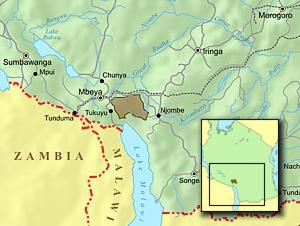
Population: 140,000
Location: Iringa Region, Makete District
Alternate Names: Kikinga, Ekikinga
The Kinga people live high in the mountain ranges to the northeast of Lake Malawi. A Kinga New Testament was published in 1961 so they have an old translation of the Bible which is not easily readable by this generation and also no longer available. Their desire to have the Bible in their language is very strong, especially for the younger generation.
Location within country: The Kinga speaking community is situated in Makete District, Iringa Region in the Kipengere Mountain Range and in the green highlands of northeastern Lake Malawi.
Geography and Climate: Savannah and gallery forest
Altitude: The Kinga live mainly in a mountainous area ranging from 1800 to 2000m. A couple of sub-villages in the southwest are situated right at the shores of Lake Malawi at an altitude of about 800m.
Population: Approximately 140,000. It is estimated that there are about 55,000 Kinga speakers in the Kinga speaking area and up to 140,000 Kinga speakers in the whole of Tanzania.
Cultural Information: Even though many Kinga are subsistence farmers, the Kinga are business people who travel extensively. They can be found in all the bigger towns and cities in Tanzania and are known for their good business skills. Due to the altitude they farm cold-resistant crops such as potatoes, wheat, peas, maize, and other crops. There is also a large wood industry in the area.
Diet and Health: The health situation in the Kinga speaking area is generally good. The temperate climate and the high altitude mean that people have sufficient nutritious food and little problems with malaria or other tropical illnesses. However, the water supply is not always good and HIV/AIDS is a very big problem due to the extensive traveling.
Economic Status: The education level is relatively high. Many Kinga who are farmers or work for the government or the church still have some business on the side.
Language Group Information: A sociolinguist survey of the Kinga was conducted by the Language Assessment team in 2003. The Kinga are actually a group of 3 different languages: Kinga, Mahanji and Magoma. It is estimated that there are about 4,500 Mahanji speakers and 9,500 Magoma speakers. The Kinga, Mahanji, and Magoma ethnic groups differentiate themselves from each other and other neighboring groups. The customs connected with traditional sacrifices are different in each group as well as other traditions concerning marriage, farming and greetings. It is very obvious that all the groups are separate ethnic groups with their own set of traditions and customs. The Kinga highly value their language and use it in many contexts of life although young people borrow many words from Swahili, the national language.
The Kinga speaking area is quite large encompassing four divisions (Lupalilo, Ukwama, Bulongwa, and Magoma) with altogether eleven wards and 77 villages. The Kinga language is passed on to children for most of whom it is the only language used until entering school. Even at school, where Swahili is the language of instruction, children often continue to use their mother tongue when unsupervised. Kinga has no dialects. There are slight differences according to different areas and villages but these are all mutually intelligible. There is no language apart from Kinga or Swahili in which Kinga could effectively use any written material. Swahili proficiency is good for many Kinga but there is a considerable portion of the Kinga speaking community that does not know Swahili to a high degree and is not able to use written material in Swahili effectively.
Religion: Christian, traditional religion
The Kinga Church: The churches in the area are very open to the idea of Bible translation into their language. The Lutheran church even has started a “Kinga day” where the worship services are held in Kinga. Other churches are the Catholics, Baptists, and some Pentecostals. In the Mbeya cluster project the different denominations are working together to develop the Kinga language and translate the Bible into it.
The churches have requested a new meaning-based translation of the New Testament, which uses a new orthography and modern Kinga, and the translation of the Old Testament. The Kinga text can then be adapted to the related Magoma/Mahanji languages. The Kinga (together with Bena) is also the closest language and have the vision to help with the next related Bantu Cluster: Pangwa, Manda and Kisi languages, for which we already have received requests from some of the church leaders.
History: The Kinga were reached by Lutheran missionaries over a hundred years ago and as a result, most call themselves Christian.
The Kinga Team: The local churches are very keen on getting the Scriptures in their heart language. The team has members from the Lutheran, Baptist, and Pentecostal churches. The team is made up of Saul L., Zakayo S. as translators, and Riwa S. as Literacy/SU coordinator.
